
William Alexander Graham was a United States senator from North Carolina from 1840 to 1843, a senator later in the Confederate States Senate from 1864 to 1865, the 30th governor of North Carolina from 1845 to 1849 and U.S. secretary of the Navy from 1850 to 1852, under President Millard Fillmore. He was the Whig Party nominee for vice-president in 1852 on a ticket with General Winfield Scott.

The Hooper–Lee–Nichols House is an historic Colonial American house in Cambridge, Massachusetts. Initially constructed in 1685 and enlarged and remodeled many times thereafter, it is located at 159 Brattle Street in Cambridge. It is the second-oldest house in the city. The house is now headquarters for History Cambridge, formerly the Cambridge Historical Society.

The Hyde Collection is an art museum in the city of Glens Falls in Upstate New York. The collections were endowed by the Hyde family. The museum is housed in a historic refurbished early twentieth-century residence, the Hyde House, located at 161 Warren Street in Glens Falls, New York, a building that is listed on the U.S. National Register of Historic Places.

The Hooper-Eliot House is an historic house in Cambridge, Massachusetts. The three-story Stick-style house was built in 1872 for E.W. Hooper to a design by Sturgis & Brigham. The building's five-bay facade and gambrel roof form an early part of the effort by Sturgis to popularize the Georgian Revival. Its original main facade oriented to the north, a new south-facing entry was designed in 1902 by Lois Lilley Howe, featuring a broken scrolled pediment above the porch. The house was purchased by Samuel Atkins Eliot in that same year.

The Old Cambridge Historic District is a historic district encompassing a residential neighborhood of Cambridge, Massachusetts that dates to colonial times. It is located just west of Harvard Square, and includes all of the properties on Brattle Street west of Mason Street to Fresh Pond Parkway, all of the properties on Mason Street and Elmwood Avenue, and nearby properties on Craigie Street. The district includes five National Historic Landmarks: Elmwood, the Reginald A. Daly House, the Oliver Hastings House, the Mary Fiske Stoughton House, and the Longfellow House–Washington's Headquarters National Historic Site, as well as several other houses listed separately on the National Register. The district follows the general route of the Watertown Path, an early colonial road that supposedly followed a Native American trail. This portion of the way became known as Tory Row during the American Revolution, because many of the fine mansions lining it were owned by Loyalists. In the 19th and early 20th centuries it continued by a fashionable location, and now features a number of architecturally significant buildings. It includes 215 contributing buildings and one other contributing sites over an area of 52 acres (21 ha). One included building is the Cambridge Historical Society's offices, which are in the NRHP-listed Hooper-Lee Nichols House, located at 159 Brattle Street.

The Robert King Hooper Mansion, built in 1728, is a historic house in Marblehead, Massachusetts. The oldest section of the mansion was built by candlemaker Greenfield Hooper, and his son, Robert "King" Hooper, expanded the house, adding its three-story Georgian façade c. 1745. Hooper made his fortune through the transatlantic fishing business.
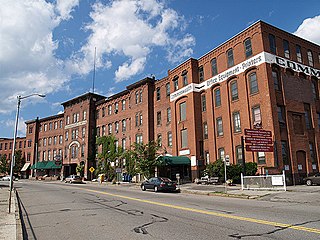
The Washburn and Moen North Works District encompass an industrial complex that housed the largest business in Worcester, Massachusetts in the second half of the 19th century.

16 Mineral Street in Reading, Massachusetts is a well-preserved Second Empire cottage. It was built c. 1874 and probably moved to its present location not long afterward, during a building boom in that part of the town. It was listed on the National Register of Historic Places in 1984.
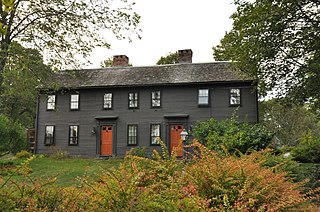
The Jabez Weston House is a historic house in Reading, Massachusetts. The older portion of this 2+1⁄2-story timber-frame house was built c. 1779 in a late-Georgian early-Federalist style. This portion consisted of a five bay section with a centrally located front door. Sometime, an eastern extension added three bays and a second entrance, converting the building into a two family residence. The property belonged to the Weston family, who were early settlers of the area.
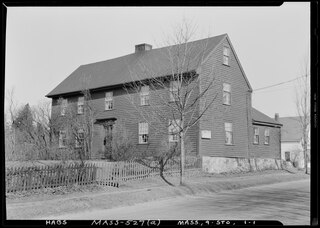
The Jonathan Green House is a historic first period Colonial American house, built c. 1700–1720. It is located at 63 Perkins Street, Stoneham, Massachusetts. It was listed on the National Register of Historic Places in 1984. It is one of the oldest structures in Stoneham, and one of only two structures in Stoneham preserving a nearly intact early eighteenth century form.

The Padilla Beard House is a historic house at 18 Maple Street in Stoneham, Massachusetts. Built about 1850, it was listed on the National Register of Historic Places in 1984 for its association with Padilla Beard, the first operator the stagecoach line on the route between Boston and Reading. The house was listed on the National Register of Historic Places in 1984.

The John Bottume House is a historic house at 4 Woodland Road in Stoneham, Massachusetts. Built c. 1849, this stone house was one of several built along the shore of Spot Pond by a Boston businessman as a retreat, and is the only one to survive. It is owned by the Massachusetts Department of Conservation and Recreation, and houses the visitors center for the Middlesex Fells Reservation. It was listed on the National Register of Historic Places in 1984.

The Walter Keene House is a historic house located at 28 High Street in Stoneham, Massachusetts. The 2+1⁄2-story wood-frame building was constructed c. 1900 and serves as an excellent local example of a transitional Queen Anne-Colonial Revival house. Its hip roof and front porch are typically Colonial Revival, while the left-side turret and turned posts and balusters exhibit Queen Anne characteristics. The house was built for Walter Keene, a local shoe salesman and banker who played a significant role in developing much of the surrounding area. Stoneham's Keene Street is named in his honor.
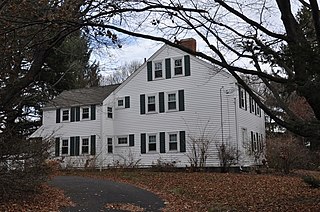
The Jonas Cowdry House is a historic house at 61 Prospect Street in Wakefield, Massachusetts. Built c. 1833, the Federal style wood-frame house is three bays wide and four deep, a significant local variant to conventional Federal style architecture. The house was listed on the National Register of Historic Places in 1989.

The Captain Goodwin–James Eustis House is a historic house in Wakefield, Massachusetts. Built about 1760 and enlarged around 1830, it is a good local example of Greek Revival architecture, which was owned by a prominent local businessman and civic leader. The house was listed on the National Register of Historic Places on March 2, 1990, where it is listed as the "Captain Goodwin–James Custis House".

28 Cordis Street is a historic house located in Wakefield, Massachusetts. It is significant as a well-preserved example of the Greek Revival style houses built during the early to mid 19th century.
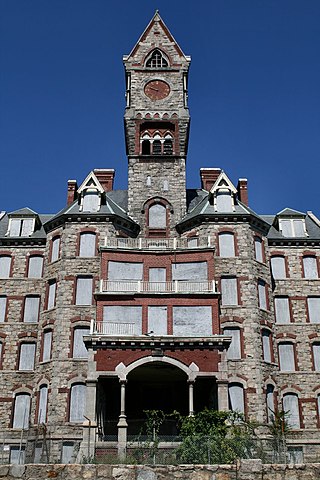
Worcester State Hospital was a Massachusetts state mental hospital located in Worcester, Massachusetts. It is credited to the architectural firm of Weston & Rand. The hospital and surrounding associated historic structures are listed as Worcester Asylum and related buildings on the National Register of Historic Places.
Hooper House may refer to:
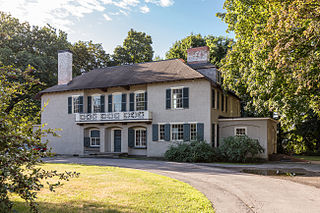
Hoopes House is a historic home located at Glens Falls, Warren County, New York. Designed by Boston architect Henry Forbes Bigelow, it was built in 1904 and is a rectangular, two story, stucco residence covered by a hipped roof sheathed with wood shingles. It features Dutch Colonial Revival style design elements. It was the home of Mary Pruyn Hoopes, the sister of Charlotte Pruyn Hyde. Charlotte Hyde was the founder of The Hyde Collection, an art museum adjacent to Hoopes House. The Hyde Collection owns Hoopes House.
There are 98 properties and historic districts on the National Register of Historic Places in Worcester, Massachusetts, east of I-190 and the north-south section of I-290, which are listed below. Two listings overlap into other parts of Worcester: one of the 1767 Milestones is located in northwestern Worcester, and the Blackstone Canal Historic District traverses all three sections of the city.





















